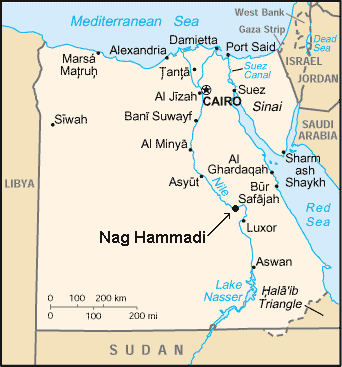As I've read through 1Nephi 13, I have wondered, “what are the plain and precious things which were removed from the Bible?” You can't tell from just reading the Bible because you don't know what isn't there that should be, so how do you tell? The Book of Mormon helps, but it's still not a clear voice on what is missing. While I was pondering on this a couple of days ago, I came across a lecture by Hugh Nibley which he gave in 1964 at BYU. It does give some interesting insights. Here is a link to an MP3 audio of the lecture. Here's the print version.
In it, Bro. Nibley said the scrolls of Qumran and the books of Nag Hammadi Library give the answer to that question. The Dead Sea Scrolls as the scrolls of Qumran are also known, were written and collected by residents of a small community known today as "Khirbet Qumran". While it is not known for certain which religious sect they were, most think they were Essenes: they were Jews. They taught the Jews at Jerusalem were in a state of apostasy, so they were trying to get back to a more pure adherence to Jewish law and scripture.
The residents of Nag Hammadi were Christians. It is located in Egypt on the Nile River about fifty miles north of Luxor. The documents in question are dated from about the first to fourth century after Christ.
What Bro. Nibley did is compare what was taught in the texts from these sites with what we have in the Bible today. He identified at least these four things:
1. The doctrine of literal resurrection of the body after death and marriage that transcends death. While Paul touches on it in 1 Corinthians 15, and the Savior often refers to Himself as the "resurrection and the life," the people of Nag Hammadi taught the doctrine much more clearly. They were branded by the church at Rome as heretics for this and other teachings.
2. The coming apostasy and loss of God's authority. According the Nibley, the people at Nag Hammadi were branded as heretics by the church in Rome for their beliefs. Nibley said they "buried" their records, as the people of Qumran did, in anticipation of a time when those records would be valued again. The Book of Mormon has its own version of this tragic loss of priesthood authority. Here we have two witnesses separated by vast distances of the same event.
3. The Savior’s post-mortal ministry (40 days) to the Jews at Jerusalem. I found this particularly interesting. The account Nibley cites gives additional insight into the Nephite's request to do for them what the Savior did in Jerusalem. See 3 Nephi 17:12-24. There's no way Joseph Smith knew of this in 1829, yet the close parallel is striking, even breathtaking.
4. The "Church of Anticipation," or a group of people who were expecting a soul saving Messiah as opposed to a militaristic Messiah who would free Israel from bondage. This was the whole focus of the community at Qumran. The Bible doesn't mention any such thing, but that's the dominant theme of the Book of Mormon: a people looking forward to the coming Savior and His atonement for them. The community of Qumran and the Dead Sea Scrolls are a clear Old World validation of this premise.
He touches on more than these items, but it is enough for me to answer the question: "what was taken out?"


No comments:
Post a Comment